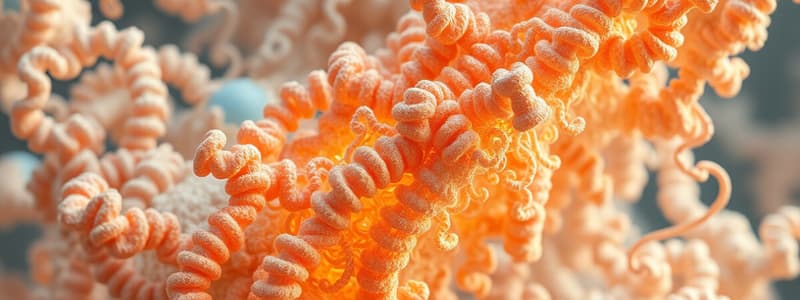Podcast
Questions and Answers
What is the primary function of myoglobin in mammals?
What is the primary function of myoglobin in mammals?
- Regulate blood pH levels
- Facilitate carbon dioxide transfer to lungs
- Store oxygen for high energy demands (correct)
- Transport oxygen from lungs to tissues
Which component is critical for the structural similarity between myoglobin and hemoglobin?
Which component is critical for the structural similarity between myoglobin and hemoglobin?
- Type of amino acid composition
- Covalent bonding patterns
- Presence of proline residues
- Number of alpha-helices (correct)
How many oxygen molecules can myoglobin bind?
How many oxygen molecules can myoglobin bind?
- One (correct)
- Four
- Two
- None
What shape does the O2 dissociation curve of hemoglobin exhibit?
What shape does the O2 dissociation curve of hemoglobin exhibit?
What type of protein structure does hemoglobin possess?
What type of protein structure does hemoglobin possess?
What stabilizes the oxygen binding to the heme group in both myoglobin and hemoglobin?
What stabilizes the oxygen binding to the heme group in both myoglobin and hemoglobin?
Which statement about myoglobin's affinity for O2 is correct?
Which statement about myoglobin's affinity for O2 is correct?
What is the P50 value for hemoglobin?
What is the P50 value for hemoglobin?
Where is hemoglobin exclusively found in the body?
Where is hemoglobin exclusively found in the body?
What type of interaction holds the polypeptide subunits of hemoglobin together?
What type of interaction holds the polypeptide subunits of hemoglobin together?
How does hemoglobin's binding affinity for O2 change as more O2 molecules bind?
How does hemoglobin's binding affinity for O2 change as more O2 molecules bind?
What is the role of charged amino acids in myoglobin's structure?
What is the role of charged amino acids in myoglobin's structure?
What is the primary form of CO2 exported from metabolism?
What is the primary form of CO2 exported from metabolism?
What characteristic of myoglobin distinguishes it from hemoglobin in terms of O2 loading and unloading?
What characteristic of myoglobin distinguishes it from hemoglobin in terms of O2 loading and unloading?
Which of the following best describes the tense (T) form of hemoglobin?
Which of the following best describes the tense (T) form of hemoglobin?
What enzyme is responsible for the hydration of CO2 into bicarbonate?
What enzyme is responsible for the hydration of CO2 into bicarbonate?
What characterizes a simple protein?
What characterizes a simple protein?
What type of protein is hemoglobin classified as?
What type of protein is hemoglobin classified as?
Which statement about fibrous proteins is accurate?
Which statement about fibrous proteins is accurate?
What is the primary role of myoglobin in the body?
What is the primary role of myoglobin in the body?
What determines the role of the heme group in hemeproteins?
What determines the role of the heme group in hemeproteins?
Which function is NOT associated with proteins?
Which function is NOT associated with proteins?
What distinguishes a conjugated protein from a simple protein?
What distinguishes a conjugated protein from a simple protein?
What is the typical composition of hemoglobin in terms of polypeptide chains?
What is the typical composition of hemoglobin in terms of polypeptide chains?
Flashcards are hidden until you start studying
Study Notes
Protein Classification
- Proteins can be classified as simple (only amino acids) or conjugated (contain prosthetic groups).
- Example of a conjugated protein: Hemoglobin, which includes heme as a prosthetic group.
- Monomeric proteins consist of a single polypeptide chain.
- Multimeric proteins are composed of multiple chains: homomultimers (same chains) and heteromultimers (different chains).
- Hemoglobin is a heterotetramer with two alpha chains and two beta chains.
Types of Protein Structures
-
Fibrous Proteins:
- Long strands or sheets of polypeptides.
- Generally water-insoluble due to high hydrophobic amino acid content.
- Strong and flexible, providing structural support (e.g., keratin, collagen).
-
Globular Proteins:
- Polypeptide chains folded into spherical shapes.
- Water-soluble and capable of diverse functions including catalysis and regulation.
Functions of Proteins
- Catalysis: Function of enzymes.
- Structural: Keratin providing structural integrity.
- Transport: Hemoglobin transports oxygen, Na+/K+ ATPases facilitate trans-membrane transport.
- Defense: Antibodies function in immune response.
- Energy Metabolism: Myosin and actin involved in muscle contraction.
- Hormonal Regulation: Insulin acts as a hormone.
- Storage: Proteins in seeds and eggs.
Hemeproteins
- Specialized proteins that contain heme, functioning as oxygen carriers.
- Hemoglobin and myoglobin are two primary human hemeproteins.
- Hemoglobin is primarily found in red blood cells and contributes to blood's red color.
Structure of Hemoglobin and Myoglobin
- Hemoglobin: Heterotetramer composed of four polypeptide chains (α2β2) and four heme groups.
- Myoglobin: Monomeric protein with a single heme group, primarily found in muscle tissue.
- Each protein contains alpha-helices and a heme group for oxygen binding.
Oxygen Binding and Transport
- Heme group binds oxygen in a non-covalent manner, supported by histidine residues.
- Myoglobin binds only one oxygen molecule; hemoglobin can bind up to four.
- Oxygen dissociation curves for both proteins differ: myoglobin exhibits a hyperbolic shape, while hemoglobin shows a sigmoidal shape due to positive cooperativity (increased affinity with each bound oxygen).
Oxygen Transportation Efficiency
- Hemoglobin is adept at loading oxygen in the lungs and releasing it in tissues.
- High affinity for oxygen at high partial pressures (in lungs) and low affinity at lower pressures (in tissues).
CO2 Export Mechanism
- CO2 is hydrated and transported primarily as bicarbonate ions in the blood.
- The reaction involving CO2 and water is facilitated by carbonic anhydrase, converting CO2 into carbonic acid and then bicarbonate.
Studying That Suits You
Use AI to generate personalized quizzes and flashcards to suit your learning preferences.




